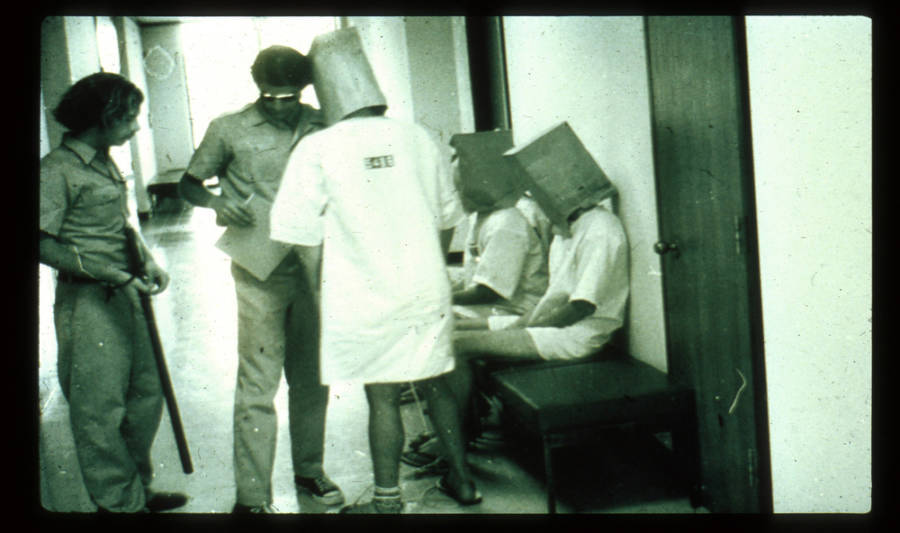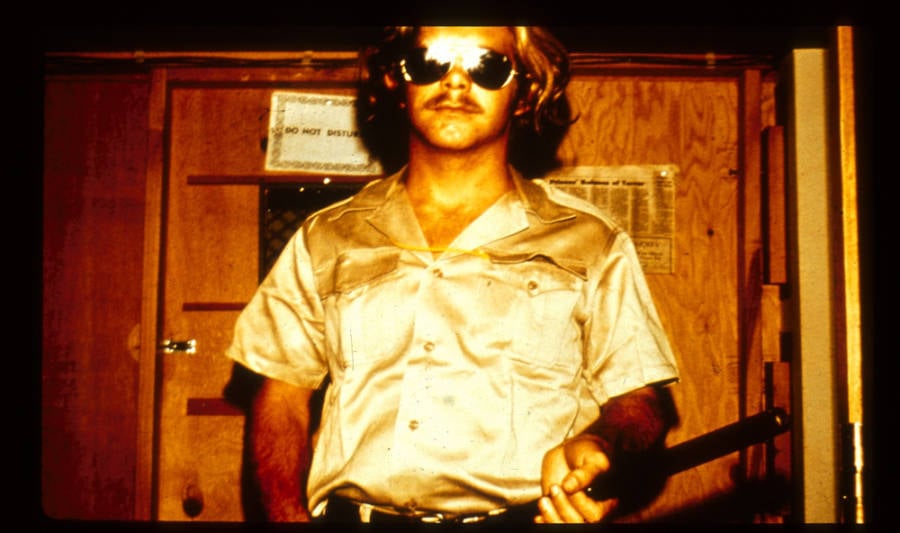One of the participants claims he faked his cries for help so he could get out of it.

Prisonexp.comVideo footage of the experiment.
“I mean, Jesus Christ, I’m burning up inside! Don’t you know? I want to get out! This is all fucked up inside! I can’t stand another night! I just can’t take it anymore!”
Screamed from within a closet by tortured 22-year-old grad student Douglas Korpi, those words are infamous in the psychological community. They were the defining moment in the Stanford Prison Experiment, one of the most infamous psychological studies of all time, the moment when it went from under control to out of hand.
It was also a lie.
According to a new exposé published in Medium, not only were Korpi’s screams faked, but the entire experiment was a sham.
In 1971, a young Stanford psychology professor named Philip Zimbardo concocted what would become a world famous experiment on the human condition in prison-like atmospheres. He hoped to better understand the inner workings of the interactions between prisoners and their guards through a two-week long role-playing exercise. To do so, he built a makeshift jail in the basement of the university’s Jordan Hall and enlisted 18 young men to play the parts of prisoners and guards.
Zimbardo’s experiment began under noble pretenses and was even funded by the U.S. Navy and the Marine Corps, but before long the cause was lost. The actors found themselves too caught up in their roles; the “guards” were becoming more sadistic and manipulative while the prisoners were slowly losing their minds.
After just six days, the experiment was shut down, but the damage was already done. Rather than serve as a window into the psychology of prison relationships, Zimbardo’s experiment became known as an example of the dark side of authority. The psychology community was left with a confusing well of knowledge, most of which seemed to imply that humanity is inherently sadistic and that all it takes is one small push to turn it loose.
However, the exposé claims that the harrowing experiment is a sham. In an interview with Medium writer Ben Blum, Douglas Korpi himself explained how his bone-chilling cries for help were nothing but an elaborate act.

Prisonexp.comPhilip Zimbardo sitting in the hallway of his makeshift prison.
“Anybody who is a clinician would know that I was faking,” Korpi said. “If you listen to the tape, it’s not subtle. I’m not that good at acting. I mean, I think I do a fairly good job, but I’m more hysterical than psychotic.”
His hysteria was warranted, though not by what Zimbardo implied. Korpi was never scared of the guards, or his situation, but by the thought of not getting into grad school.
“The reason I took the job was that I thought I’d have every day to sit around by myself and study for my GREs,” he explained, alluding to the fact that the volunteers hadn’t quite been briefed on what to expect. During his time in the makeshift cell, he asked for his books to study for his Graduate Record Exams, but was denied. After several more attempts were shut down, Korpi realized there was “no point” to being there anymore.
Korpi admitted his infamous breakdown, heard on the tapes of the experiments, was nothing more than an attempt to be let out of the experiment so he could return to studying. For the most part, he said, being in the pretend prison was enjoyable.
“[The first day] was really fun,” Korpi said. “The rebellion was fun. There were no repercussions. We knew [the guards] couldn’t hurt us, they couldn’t hit us. They were white college kids just like us, so it was a very safe situation. It was just a job. If you listen to the tape, you can hear it in my voice: I have a great job. I get to yell and scream and act all hysterical. I get to act like a prisoner. I was being a good employee. It was a great time.”
Supporting Korpi’s claims that the experiment was just an act is David Jaffe, the undergraduate who served as the makeshift prison’s warden. While Zimbardo insists that the experiment was his own idea, Jaffe claims he was actually the mastermind.
Three months before the experiment took place, Jaffe and several fellow students came up with the experiment as an assignment for Zimbardo’s class. They created the rules and the scenario and even enlisted a former San Quentin State Prison inmate as a consultant. When Zimbardo heard their proposal, he expressed interest in carrying it out in real life, and gave Jaffe creative control.
“I was asked to suggest tactics based on my previous experience as master sadist,” Jaffe recalled in a post-experiment evaluation. “I was given the responsibility of trying to elicit ‘tough-guard’ behavior.”

Prisonexp.comOne of the “guards.”
Zimbardo claimed the guards came up with all of their behaviors and actions on their own, but Jaffe explained that Zimbardo gave them examples.
“The guards have to know that every guard is going to be what we call a tough guard,” Jaffe told one such guard on his taped evaluation. “[H]opefully what will come out of this study is some very serious recommendations for reform… so that we can get on the media and into the press with it, and say ‘Try and react as you picture the pigs reacting.'”
Though evidence exists that almost all parts of the experiment were faked, there was one part that was real. Just like normal prisoners, those portraying the roles of inmates were expected to participate for the full two weeks. Even if they wanted to leave, they were told they couldn’t.
Tapes of the experiments reveal Zimbardo telling his staff that he denied two men’s requests to leave.
“An interesting thing was that the guys who came in yesterday, the two guys who came in and said they wanted to leave, and I said no,” Zimbardo can be heard saying. “There are only two conditions under which you can leave, medical help or psychiatric… I think they really believed they can’t get out.”
However, according to Zimbardo himself, there was always an out. In a phone interview with Blum, Zimbardo said there was a section of the informed consent forms that the volunteers filled out that contained an explicit safe phrase: “I quit the experiment.”
“None of them said that,” Zimbardo said. “They said, ‘I want out. I want a doctor. I want my mother,’ etc., etc. Essentially I was saying, ‘You have to say, “I quit the experiment.’”
The informed consent forms as seen on Zimbardo’s website do not show these words.
Since the publication of the exposé (and even before it), the psychology community has questioned the experiment, calling it everything from “misleading” to “a complete sham.” Regardless of what the experiment once achieved, its legacy is now marred by these recent claims.
Next, read about the most terrifying experiments ever conducted. Then, read about the worst prisons in the world.





